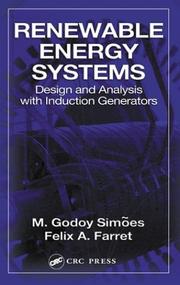| Listing 1 - 4 of 4 |
Sort by
|
Book
ISBN: 1839530014 Year: 2021 Publisher: Stevenage : Institution of Engineering & Technology,
Abstract | Keywords | Export | Availability | Bookmark
 Loading...
Loading...Choose an application
- Reference Manager
- EndNote
- RefWorks (Direct export to RefWorks)
This book covers the use of fuzzy logic for power grids. Power systems need to accommodate intermittent renewables and changes in loads while ensuring high power quality. Fuzzy logic uses values between 0 and 1 rather than binary ones, offering advantages in adaptability for energy systems with renewables.
Smart power grids --- Engineering --- Technology & Engineering --- Design and construction. --- Engineering --- Technology & Engineering

ISBN: 0849320313 Year: 2004 Publisher: Boca Raton, FL : CRC Press,
Abstract | Keywords | Export | Availability | Bookmark
 Loading...
Loading...Choose an application
- Reference Manager
- EndNote
- RefWorks (Direct export to RefWorks)
Renewable Energy Systems: Design and Analysis with Induction Generators focuses on renewable energy applications with emphasis on the modeling, driving, and use of induction generators for power generation. It covers all topics related to design, operation, and overall analysis of such systems as well as everything from the very basic topics on induction generators to the latest technologies for association, controls, automation, and power electronics. Each chapter introduces a feature problem related to the technology discussed in that chapter and then solves the problem and proposes additional exercises. The use of MATLAB and Simulink is integrated throughout the book
Renewable energy sources --- Energies renouvelables --- Asynchrone machines --- Duurzame energie --- Elektrische energie --- Windturbines --- Asynchrone machines. --- Duurzame energie. --- Elektrische energie. --- Windturbines.
Book
ISBN: 1119058473 1119058279 1119058457 Year: 2017 Publisher: Hoboken, New Jersey : [Piscataqay, New Jersey] : John Wiley & Sons, IEEE Xplore,
Abstract | Keywords | Export | Availability | Bookmark
 Loading...
Loading...Choose an application
- Reference Manager
- EndNote
- RefWorks (Direct export to RefWorks)
Discusses the application of mathematical and engineering tools for modeling, simulation and control oriented for energy systems, power electronics and renewable energy This book builds on the background knowledge of electrical circuits, control of dc/dc converters and inverters, energy conversion and power electronics. The book shows readers how to apply computational methods for multi-domain simulation of energy systems and power electronics engineering problems. Each chapter has a brief introduction on the theoretical background, a description of the problems to be solved, and objectives to be achieved. Block diagrams, electrical circuits, mathematical analysis or computer code are covered. Each chapter concludes with discussions on what should be learned, suggestions for further studies and even some experimental work. . Discusses the mathematical formulation of system equations for energy systems and power electronics aiming state-space and circuit oriented simulations. Studies the interactions between MATLAB and Simulink models and functions with real-world implementation using microprocessors and microcontrollers. Presents numerical integration techniques, transfer-function modeling, harmonic analysis and power quality performance assessment. Examines existing software such as, MATLAB/Simulink, Power Systems Toolbox and PSIM to simulate power electronic circuits including the use of renewable energy sources such as wind and solar sources Modeling Power Electronics and Interfacing Energy Conversion Systems serves as a reference for undergraduate and graduate students studying electrical engineering as well as practicing engineers interested in power electronics, power systems, power quality and alternative or renewable energy.
Power electronics --- Energy conversion --- Mathematical models. --- Mathematical models.
Book
Year: 2007 Publisher: Golden, Colo. : National Renewable Energy Laboratory,
Abstract | Keywords | Export | Availability | Bookmark
 Loading...
Loading...Choose an application
- Reference Manager
- EndNote
- RefWorks (Direct export to RefWorks)
| Listing 1 - 4 of 4 |
Sort by
|

 Search
Search Feedback
Feedback About UniCat
About UniCat  Help
Help News
News